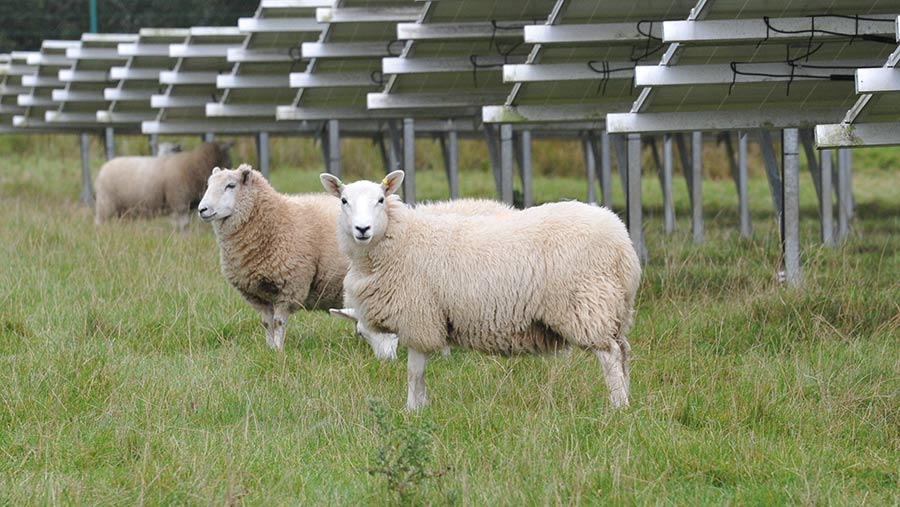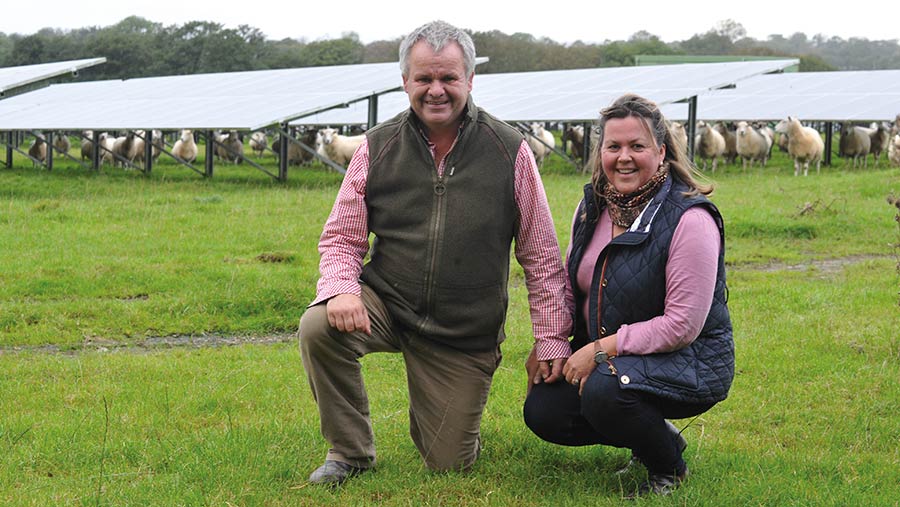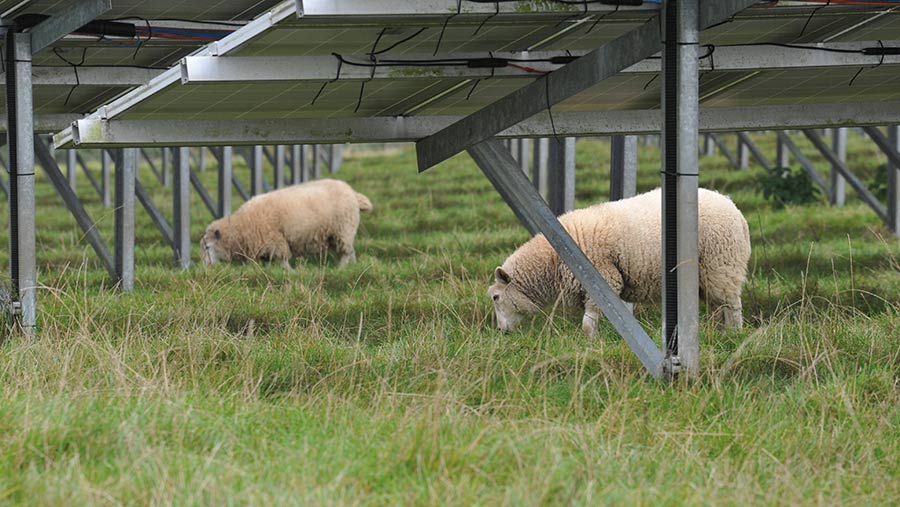How solar panel diversification is working for a sheep enterprise
 © Debbie james
© Debbie james Leasing land to a company for a 47MW solar park is generating a reliable income for farmers Stephen and Clare Morgan, at Fenton Home Farm, near Haverfordwest.
It dovetails nicely with their existing sheep enterprise, with the land still grazed by 300 breeding ewes and their progeny.
Although they have had to adapt their sheep system to fit into the solar park, it is an arrangement that works well, says Mrs Morgan, who explains that the sheep are used as “lawn mowers” to manage grass while producing lambs.
See also: Business Clinic: How would solar lease affect IHT reliefs?
Farm facts
Fenton Home Farm, near Haverfordwest, Pembrokeshire
- 134ha (331 acres) owned
- 300 breeding ewes
- Lambs mostly sold liveweight through JJ Morris, Whitland Mart
- 200 fattening cattle sold deadweight
- 64,000 free-range layers – 120kW ground-mounted solar panels to power poultry sheds
- 25 long-let rental properties and four holiday rentals
- 350kW biomass boiler to generate heat and hot water for the rental properties
About the solar park
The £46m park was developed in 2014, when the business leased 61ha (151 acres) to a solar generation company on a 30-year agreement.
A further 13ha (32 acres) was brought into the scheme the following year, taking the development to 74ha (183 acres).
The solar panels are linked to an electricity substation 2km from the farm. The agreement is index-linked, and ownership of the fixings transfers to the Morgans when it ends.
A sum has been allowed in the agreement for dismantling and disposing of the panels, although it is likely that another company may take it on.
Mr Morgan believes the decision to diversify into solar was helped by the farm not having sentimental value.
Fenton Home Farm hasn’t been in the family for generations – Mr Morgan bought it when he moved to Pembrokeshire in 1999.
“We don’t have the same emotional attachment to it. Solar made sense for us because as a business we have always spread our risk and it secures a future without subsidies.”
The land had been used in an arable rotation. Grass leys were established before the panels were erected.
As part of the lease agreement, the Morgans must manage the grass, weeds and hedges.
All the equipment is protected with guards, so sheep grazing was a good option as the land could be grazed without risk of damage to the wiring.

Stephen and Clare Morgan © Debbie James
Adaptations
Adjustments were needed to the sheep enterprise, with the most significant being a change of breed.
The flock had been Welsh Mule ewes sired to a Texel, but the animals were too big to graze underneath the solar panels.
Therefore, a smaller type of ewe was sought. The Morgans opted for Aberfield ewes sired with Primera and Abertex genetics
The solar park is stocked at 12 sheep/ha in the summer. This drops to 5/ha over the winter months. It took a while for the sheep to adjust to the panels.
“We recently bought in 75 ewe lamb replacements and once we had finished quarantining them, we ran them with the ewes so they would adapt to the different environment,” explains Mrs Morgan.
They couldn’t manage the sheep without dogs, she adds. “You need good, steady dogs for getting the sheep on and off the fields, and the dogs must get used to the panels too.
“It can be difficult to see the sheep as the panels create lots of obstacles.”
The number of times the flock must be rounded up is kept to a minimum, as there is a greater chance of injury from the mounts of the panels.
“Having a high-dependency ewe wouldn’t work; you want to be handling them as little as possible,’’ says Mr Morgan.
The flock lambs from the beginning of April, with only the singles lambed on the solar land – the twins and triplets are housed two weeks before lambing.
The panels have the added benefit of providing shade from the hot sun and shelter for the young lambs when weather conditions are challenging.
The solar land is mostly rested for three months from November. There is other land the flock can use, and some ewes are sent away to tack grazing for those months.
With stone tracks running through the solar park fields, supplementary feeding can be accommodated, if needed, before and after lambing.

© Debbie James
Downsides
One of the downsides is that the land can not be used to grow wheat for the poultry enterprise.
“We had 350 acres [142ha] in one block and lost 180 acres [73ha] of it, so it has limited the rest of the farming enterprise,” Mr Morgan admits.
Managing the grazing can be tricky. “We try to graze very tightly, so we must get the sheep numbers right. If a field gets away, you can’t just lock it up for silage,” Mr Morgan explains.
It is not possible to reseed the land, so there will be a nutritional penalty going forward, and the shade from the panels diminishes the sugar content of the swards, too.
The stocking rate will have to be reduced accordingly as the quality of the grass becomes poorer, they say.
This means lambs can’t be fattened on the land and must be moved to achieve this.
“We can grow frames of lambs and grow a good store lamb,” says Mrs Morgan.
The space between the panels is two metres on the south-facing 61ha (150-acre) block and three metres on the north-facing 13ha (32 acres); this only allows sufficient access for a quad bike.
“When a solar park is set up, farming isn’t a priority for the energy company. They design it to get the highest possible number of panels on the land,” explains Mr Morgan.
Weed control and fertiliser
A quad-mounted spinner is used to spread fertiliser, although none has been applied this year because the response rate would not have been enough to generate a sufficient return on the high cost of that investment.
For weed control, if it cannot be managed by tight grazing then it is sprayed once at the beginning of the summer.
There are fenced-off sections, and narrow corridors of land such as headlands that need to be managed; suckler cows and calves are used for this.
“If you are not careful, these could turn into rough grass margins,” says Mr Morgan.
The solar has been a big change to the way they used to farm.
“Leasing your land for 30 years or more would not appeal to everyone,’’ says Mr Morgan.
But the diversified nature of the business creates opportunities for the couple’s three sons, Huw, Evan, and Tom, should they want to farm one day.
The Morgans’ advice to others considering solar
- If you are approached by a solar company, don’t rush to sign an agreement – contact other companies to gauge their interest first
- Use a land agent and solicitor specialising in renewable energy
- Proximity to an electricity substation is crucial; this is one of the reasons we were approached, as well as because we have south-facing land
